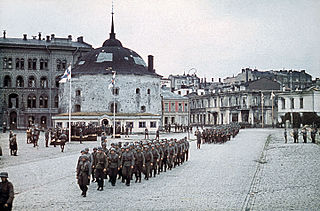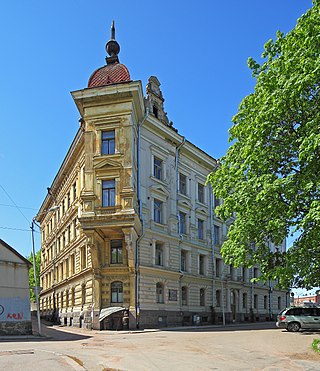The Northern Front was a front of the Red Army during the Second World War.

The Vyborg–Petrozavodsk offensive or Karelian offensive was a strategic operation by the Soviet Leningrad and Karelian Fronts against Finland on the Karelian Isthmus and East Karelia fronts of the Continuation War, on the Eastern Front of World War II. The Soviet forces captured East Karelia and Vyborg/Viipuri. After that, however, the fighting reached a stalemate.

The Leningrad Military District is a military district of the Armed Forces of the Russian Federation. In 2010 it was merged with the Moscow Military District, the Northern Fleet and the Baltic Fleet to form the new Western Military District. In December 2022, Defense Minister Sergey Shoigu proposed to reestablish it along with the Moscow Military District, a decision confirmed in June 2023 by Deputy Chief of the General Staff Yevgeny Burdinsky. On December 17, 2023 Vladimir Putin announced plans to recreate the Leningrad Military District as a reaction to Finland joining NATO. The district was formally reconstituted on February 26, 2024 by a Presidential Decree.

The Finnish invasion of the Karelian Isthmus refers to a military campaign carried out by Finland in 1941. It was part of what is commonly referred to as the Continuation War. Early in the war Finnish forces liberated the Karelian Isthmus. It had been ceded to the Soviet Union on 13 March 1940, in the Moscow Peace Treaty, which marked the end of the Winter War. Later, in the summer of 1944, the Soviet Union reconquered the southern part of the isthmus in the Vyborg–Petrozavodsk Offensive.
The 13th Army was a name given to several field armies of the Soviet Union's Red Army. Later armies existed until the 1990s, and the army survived as part of the Ukrainian Ground Forces for some years.
The 14th Army was a field army of the Soviet Army, formed twice.

The Battle of Tali–Ihantala was part of the Finnish-Soviet Continuation War (1941–1944), which occurred during World War II. The battle was fought between Finnish forces—using war materiel provided by Germany—and Soviet forces. To date, it is the largest battle in the history of the Nordic countries.
The 10th Mechanized Corps was a formation in the Soviet Red Army during the Second World War.

The 30th Guards Leningrad Army Corps was an army corps of the Soviet Ground Forces. As part of the Red Army during the Great Patriotic War it was designated the 30th Guards Rifle Corps.
The 42nd Army was a field army of the Soviet Union's Red Army, created in 1941.
The 109th Rifle Division was a Red Army infantry division that was formed three times, briefly in 1939, during 1942, and again from 1942 to 1946. The first formation of the division was converted to a mechanized division after about nine months. Its second formation served for six months in 1942 in the defense of the fortress of Sevastopol, in the southern sector of the siege lines. After being destroyed there in July, a third division was formed by re-designating an existing rifle division near Leningrad in August, and it successfully held its positions for nearly a year and a half, in spite of shortages of food and supplies due to the German/Finnish siege. The 109th then participated in the Leningrad–Novgorod Offensive that drove the Germans and Finns away from the city and lifted the siege in early 1944, helped drive Finland out of the war in the Vyborg–Petrozavodsk Offensive, and then joined the offensive along the Baltic coast towards Germany. This third formation compiled an admirable record of service, but was disbanded in 1946.
The 142nd Rifle Division began service in August 1939 as a standard Red Army rifle division, which participated in the Winter War against Finland. It remained on the Karelian Isthmus and had a relatively uneventful war facing the Finns until the Vyborg–Petrozavodsk Offensive began on June 10, 1944, from which point it saw much more active service. Following the end of the Continuation War, the division was transferred to 2nd Shock Army in 2nd Belorussian Front. Its soldiers distinguished themselves in the capture of the German city of Graudenz and ended the war fighting through Pomerania.
The 313th Rifle Division was a standard Red Army rifle division formed on July 15, 1941 in the Udmurt ASSR before being sent to the vicinity of Leningrad, first in the 7th Separate Army east of Lake Ladoga, and later in 32nd Army of Karelian Front, where it spent most of the war facing the Finnish Army in East Karelia. In consequence the division saw relatively uneventful service on this mostly quiet front until the summer of 1944, when it took part in the offensive that drove Finland out of the war. When this was accomplished, the division was redeployed to take the fight into Poland and then into the German heartland in the winter and spring of 1945. It ended the war north of Berlin after compiling a very distinguished record of service.
The 286th Rifle Division was an infantry division of the Soviet Union's Red Army during World War II. Formed in the summer of 1941, the division entered combat during the fall of that year, fighting in operations attempting to break the siege of Leningrad. The division fought in the same area until the relief of Leningrad in February 1944, when it was transferred northwards to fight in the Vyborg–Petrozavodsk Offensive, which ended the Continuation War. The division was transferred to Poland with the end of the Continuation War, and fought in the Vistula–Oder Offensive and the Prague Offensive in early 1945. The division was disbanded soon after the end of the war in the summer of 1945.
The 281st Rifle Division was an infantry division of the Soviet Union's Red Army during World War II. Formed in the summer of 1941, the division fought in the siege of Leningrad until the end of the siege in early 1944, when it advanced into eastern Estonia. The 281st was soon moved north to fight against Finland during the summer of that year, and after Finland's withdrawal from the war fought in battles in East Prussia and Poland during early 1945. The division was disbanded in the summer of 1945.
The 69th Covering Brigade is a unique border protection brigade of the Russian Ground Forces, stationed at Babstovo, Jewish Autonomous Oblast, and part of the 35th Army. Military Unit в/ч 61424.
The 268th Rifle Division was an infantry division of the Soviet Union's Red Army during World War II.
The 265th Motor Rifle Division was a motorized infantry division of the Soviet Army during the Cold War.
The 358th Rifle Division formed in August 1941, as a standard Red Army rifle division, at Buguruslan. It first saw action in January 1942, taking part in the offensive northwest of Moscow which carved out the salient around Toropets deep in the rear of Army Group Center. The division remained on this general sector of the front, nearly the whole time in 4th Shock Army, until March 1944, when it was withdrawn for rebuilding. It was then assigned to 21st Army north of Leningrad where it participated in the offensive that drove Finland out of the war from June into August, and remained on this front until December. It was then reassigned to the 39th Army, under which it fought in East Prussia until April 1945. During that month the entire 39th Army began moving to the Far East, where it took part in the Soviet invasion of Manchuria in August, where the 358th won its second battle honor, capping a distinguished record of service.
The 224th Rifle Division was an infantry division of the Red Army, originally formed as one of the first reserve rifle divisions following the German invasion of the USSR. A large part of this first formation took part in amphibious landings near Kerch in late December 1941 but it was encircled and destroyed during the Battle of the Kerch Peninsula in May 1942.




